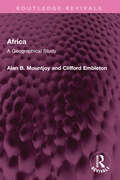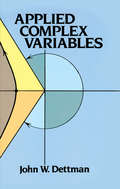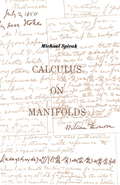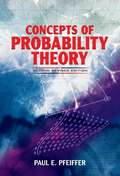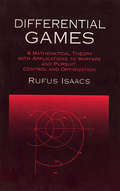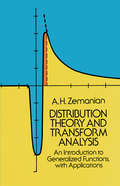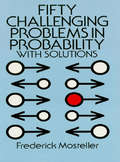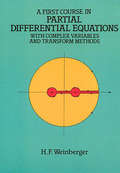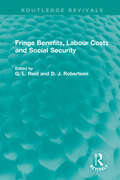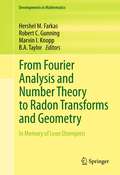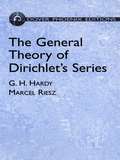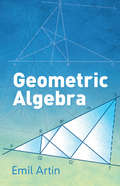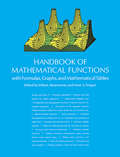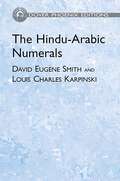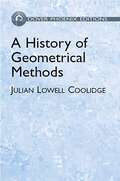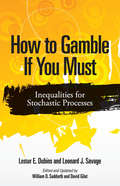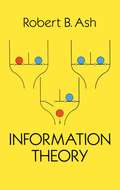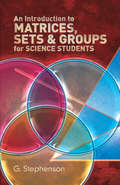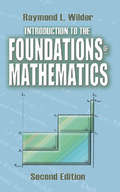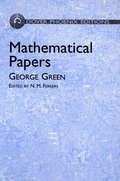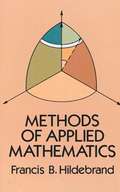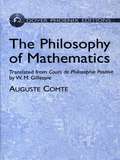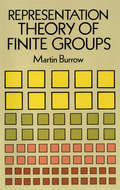- Table View
- List View
Africa: A Geographical Study (Routledge Revivals)
by Alan B Mountjoy Clifford EmbletonFirst published in 1965, Africa provides a geographical, political, economic and social description of the continent. Contemporary Africa is a continent of change and revolutions. The diversity and limitations of the African environment gives us a fuller understanding of the explosive dynamism of the African economic and social scene. This book will be of interest to students of geography, economy, anthropology and political science.
Applied Complex Variables (Dover Books on Mathematics)
by John W. DettmanAnalytic function theory is a traditional subject going back to Cauchy and Riemann in the 19th century. Once the exclusive province of advanced mathematics students, its applications have proven vital to today's physicists and engineers. In this highly regarded work, Professor John W. Dettman offers a clear, well-organized overview of the subject and various applications -- making the often-perplexing study of analytic functions of complex variables more accessible to a wider audience.The first half of Applied Complex Variables, designed for sequential study, is a step-by-step treatment of fundamentals, presenting superior coverage of concepts of complex analysis, including the complex number plane; functions and limits; the Cauchy-Riemann conditions for differentiability; Riemann surfaces; the definite integral; power series; meromorphic functions; and much more. The second half provides lucid exposition of five important applications of analytic function theory, each approachable independently of the others: potential theory; ordinary differential equations; Fourier transforms; Laplace transforms; and asymptotic expansions. Helpful exercises are included at the end of each topic in every chapter. The two-part structure of Applied Complex Variables affords the college instructor maximum classroom flexibility. Once fundamentals are mastered, applications can be studied in any sequence desired. Depending on how many are selected for study, Professor Dettman's impressive text is ideal for either a one- or two-semester course. And, of course, the ambitious student possessing a knowledge of basic calculus will find its straightforward approach rewarding to his independent study efforts.Applied Complex Variables is a cogent, well-written introduction to an important and exciting branch of advanced mathematics -- serving both the theoretical needs of the mathematics specialist and the applied math needs of the physicist and engineer. Students and teachers alike will welcome this timely, moderately priced reissue of a widely respected work.
Calculus On Manifolds
by Michael SpivakThis little book is especially concerned with those portions of ”advanced calculus” in which the subtlety of the concepts and methods makes rigor difficult to attain at an elementary level. The approach taken here uses elementary versions of modern methods found in sophisticated mathematics. The formal prerequisites include only a term of linear algebra, a nodding acquaintance with the notation of set theory, and a respectable first-year calculus course (one which at least mentions the least upper bound (sup) and greatest lower bound (inf) of a set of real numbers). Beyond this a certain (perhaps latent) rapport with abstract mathematics will be found almost essential.
Calculus On Manifolds
by Michael SpivakThis little book is especially concerned with those portions of "advanced calculus" in which the subtlety of the concepts and methods makes rigor difficult to attain at an elementary level. The approach taken here uses elementary versions of modern methods found in sophisticated mathematics. The formal prerequisites include only a term of linear algebra, a nodding acquaintance with the notation of set theory, and a respectable first-year calculus course (one which at least mentions the least upper bound (sup) and greatest lower bound (inf) of a set of real numbers). Beyond this a certain (perhaps latent) rapport with abstract mathematics will be found almost essential.<P><P> Advisory: Bookshare has learned that this book offers only partial accessibility. We have kept it in the collection because it is useful for some of our members. To explore further access options with us, please contact us through the Book Quality link on the right sidebar. Benetech is actively working on projects to improve accessibility issues such as these.
Concepts of Probability Theory: Second Revised Edition
by Paul E. PfeifferThis approach to the basics of probability theory employs the simple conceptual framework of the Kolmogorov model, a method that comprises both the literature of applications and the literature on pure mathematics. The author also presents a substantial introduction to the idea of a random process. Intended for college juniors and seniors majoring in science, engineering, or mathematics, the book assumes a familiarity with basic calculus.After a brief historical introduction, the text examines a mathematical model for probability, random variables and probability distributions, sums and integrals, mathematical expectation, sequence and sums of random variables, and random processes. Problems with answers conclude each chapter, and six appendixes offer supplementary material. This text provides an excellent background for further study of statistical decision theory, reliability theory, dynamic programming, statistical game theory, coding and information theory, and classical sampling statistics.
Differential Games: A Mathematical Theory with Applications to Warfare and Pursuit, Control and Optimization
by Rufus IsaacsOne of the definitive works in game theory, this fascinating volume offers an original look at methods of obtaining solutions for conflict situations. Combining the principles of game theory, the calculus of variations, and control theory, the author considers and solves an amazing array of problems: military, pursuit and evasion, games of firing and maneuver, athletic contests, and many other problems of conflict.Beginning with general definitions and the basic mathematics behind differential game theory, the author proceeds to examinations of increasingly specific techniques and applications: dispersal, universal, and equivocal surfaces; the role of game theory in warfare; development of an effective theory despite incomplete information; and more. All problems and solutions receive clearly worded, illuminating discussions, including detailed examples and numerous formal calculations.The product of fifteen years of research by a highly experienced mathematician and engineer, this volume will acquaint students of game theory with practical solutions to an extraordinary range of intriguing problems.
Distribution Theory and Transform Analysis: An Introduction to Generalized Functions, with Applications (Dover Books on Mathematics)
by A. H. ZemanianThis well-known text provides a relatively elementary introduction to distribution theory and describes generalized Fourier and Laplace transformations and their applications to integrodifferential equations, difference equations, and passive systems. Suitable for a graduate course for engineering and science students or for an advanced undergraduate course for mathematics majors. 1965 edition.
Fifty Challenging Problems in Probability with Solutions (Dover Books on Mathematics)
by Frederick MostellerCan you solve the problem of "The Unfair Subway"? Marvin gets off work at random times between 3 and 5 p.m. His mother lives uptown, his girlfriend downtown. He takes the first subway that comes in either direction and eats dinner with the one he is delivered to. His mother complains that he never comes to see her, but he says she has a 50-50 chance. He has had dinner with her twice in the last 20 working days. Explain. Marvin's adventures in probability are one of the fifty intriguing puzzles that illustrate both elementary ad advanced aspects of probability, each problem designed to challenge the mathematically inclined. From "The Flippant Juror" and "The Prisoner's Dilemma" to "The Cliffhanger" and "The Clumsy Chemist," they provide an ideal supplement for all who enjoy the stimulating fun of mathematics. Professor Frederick Mosteller, who teaches statistics at Harvard University, has chosen the problems for originality, general interest, or because they demonstrate valuable techniques. In addition, the problems are graded as to difficulty and many have considerable stature. Indeed, one has "enlivened the research lives of many excellent mathematicians." Detailed solutions are included. There is every probability you'll need at least a few of them.
A First Course in Partial Differential Equations: with Complex Variables and Transform Methods
by H. F. WeinbergerThis popular text was created for a one-year undergraduate course or beginning graduate course in partial differential equations, including the elementary theory of complex variables. It employs a framework in which the general properties of partial differential equations, such as characteristics, domains of independence, and maximum principles, can be clearly seen. The only prerequisite is a good course in calculus.Incorporating many of the techniques of applied mathematics, the book also contains most of the concepts of rigorous analysis usually found in a course in advanced calculus. These techniques and concepts are presented in a setting where their need is clear and their application immediate. Chapters I through IV cover the one-dimensional wave equation, linear second-order partial differential equations in two variables, some properties of elliptic and parabolic equations and separation of variables, and Fourier series. Chapters V through VIII address nonhomogeneous problems, problems in higher dimensions and multiple Fourier series, Sturm-Liouville theory, and general Fourier expansions and analytic functions of a complex variable. The last four chapters are devoted to the evaluation of integrals by complex variable methods, solutions based on the Fourier and Laplace transforms, and numerical approximation methods. Numerous exercises are included throughout the text, with solutions at the back.
Fringe Benefits, Labour Costs and Social Security (Routledge Revivals)
by G. L. Reid D. J. RobertsonOriginally published in 1965, this book is concerned with an important yet neglected part of economic life ‘fringe benefits’ which employers provide for and on behalf of their employees apart from wages and salaries. The book sets out results of an inquiry into the costs of supplementary labour costs for manual workers, with an account of the various influences which help to explain differences in expenditure by different firms. The book then gives comparative figures for Western European countries and considers some of the economic effects of the European levels of supplementary labour costs. The situation in the USA is discussed, as is the relationship of employer-financed welfare schemes and State social security programmes. Chapters on pensions, sick pay and redundancy payments are included as well as those dealing with the history of paid holidays and subsidized welfare facilities such as canteens.
From Fourier Analysis and Number Theory to Radon Transforms and Geometry
by Hershel M. Farkas Robert C. Gunning Marvin I. Knopp B. A. TaylorA memorial conference for Leon Ehrenpreis was held at Temple University, November 15-16, 2010. In the spirit of Ehrenpreis's contribution to mathematics, the papers in this volume, written by prominent mathematicians, represent the wide breadth of subjects that Ehrenpreis traversed in his career, including partial differential equations, combinatorics, number theory, complex analysis and a bit of applied mathematics. With the exception of one survey article, the papers in this volume are all new results in the various fields in which Ehrenpreis worked . There are papers in pure analysis, papers in number theory, papers in what may be called applied mathematics such as population biology and parallel refractors and papers in partial differential equations. The mature mathematician will find new mathematics and the advanced graduate student will find many new ideas to explore. A biographical sketch of Leon Ehrenpreis by his daughter, a professional journalist, enhances the memorial tribute and gives the reader a glimpse into the life and career of a great mathematician.
The General Theory of Dirichlet's Series (Dover Books on Mathematics)
by G. H. Hardy Marcel RieszThis classic work explains the theory and formulas behind Dirichlet's series and offers the first systematic account of Riesz's theory of the summation of series by typical means. Its authors rank among the most distinguished mathematicians of the twentieth century: G. H. Hardy is famous for his achievements in number theory and mathematical analysis, and Marcel Riesz's interests ranged from functional analysis to partial differential equations, mathematical physics, number theory, and algebra.Following an introduction, the authors proceed to a discussion of the elementary theory of the convergence of Dirichlet's series, followed by a look at the formula for the sum of the coefficients of a Dirichlet's series in terms of the order of the function represented by the series. They continue with an examination of the summation of series by typical means and of general arithmetic theorems concerning typical means. After a survey of Abelian and Tauberian theorems and of further developments of the theory of functions represented by Dirichlet's series, the text concludes with an exploration of the multiplication of Dirichlet's series.
Geometric Algebra (Dover Books on Mathematics)
by Emil ArtinThis concise classic presents advanced undergraduates and graduate students in mathematics with an overview of geometric algebra. The text originated with lecture notes from a New York University course taught by Emil Artin, one of the preeminent mathematicians of the twentieth century. The Bulletin of the American Mathematical Society praised Geometric Algebra upon its initial publication, noting that "mathematicians will find on many pages ample evidence of the author's ability to penetrate a subject and to present material in a particularly elegant manner."Chapter 1 serves as reference, consisting of the proofs of certain isolated algebraic theorems. Subsequent chapters explore affine and projective geometry, symplectic and orthogonal geometry, the general linear group, and the structure of symplectic and orthogonal groups. The author offers suggestions for the use of this book, which concludes with a bibliography and index.
Handbook of Mathematical Functions: with Formulas, Graphs, and Mathematical Tables
by Milton Abramowitz Irene A. StegunDespite the increasing use of computers, the basic need for mathematical tables continues. Tables serve a vital role in preliminary surveys of problems before programming for machine operation, and they are indispensable to thousands of engineers and scientists without access to machines. Because of automatic computers, however, and because of recent scientific advances, a greater variety of functions and a higher accuracy of tabulation than have been available until now are required.In 1954, a conference on mathematical tables, sponsored by M.I.T. and the National Science Foundation, met to discuss a modernization and extension of Jahnke and Emde's classical tables of functions. This volume, published 10 years later by the U.S. Department of Commerce, is the result. Designed to include a maximum of information and to meet the needs of scientists in all fields, it is a monumental piece of work, a comprehensive and self-contained summary of the mathematical functions that arise in physical and engineering problems.The book contains 29 sets of tables, some to as high as 20 places: mathematical constants; physical constants and conversion factors (6 tables); exponential integral and related functions (7); error function and Fresnel integrals (12); Bessel functions of integer (12) and fractional (13) order; integrals of Bessel functions (2); Struve and related functions (2); confluent hypergeometric functions (2); Coulomb wave functions (2); hypergeometric functions; Jacobian elliptic and theta functions (2); elliptic integrals {9); Weierstrass elliptic and related functions; parabolic cylinder functions {3); Mathieu functions (2); spheroidal wave functions (5); orthogonal polynomials (13); combinatorial analysis (9); numerical interpolation, differentiation and integration (11); probability functions (ll); scales of notation (6); miscellaneous functions (9); Laplace transforms (2); and others.Each of these sections is prefaced by a list of related formulas and graphs: differential equations, series expansions, special functions, and other basic relations. These constitute an unusually valuable reference work in themselves. The prefatory material also includes an explanation of the numerical methods involved in using the tables that follow and a bibliography. Numerical examples illustrate the use of each table and explain the computation of function values which lie outside its range, while the editors' introduction describes higher-order interpolation procedures. Well over100 figures illustrate the text.In all, this is one of the most ambitious and useful books of its type ever published, an essential aid in all scientific and engineering research, problem solving, experimentation and field work. This low-cost edition contains every page of the original government publication.
The Hindu-Arabic Numerals (Dover Books on Mathematics)
by David Eugene Smith Louis Charles KarpinskiThe numbers that we call Arabic are so familiar throughout Europe and the Americas that it can be difficult to realize that their general acceptance in commercial transactions is a matter of only the last four centuries and they still remain unknown in parts of the world.In this volume, one of the earliest texts to trace the origin and development of our number system, two distinguished mathematicians collaborated to bring together many fragmentary narrations to produce a concise history of Hindu-Arabic numerals. Clearly and succinctly, they recount the labors of scholars who have studied the subject in different parts of the world; they then assess the historical testimony and draw conclusions from its evidence. Topics include early ideas of the origin of numerals; Hindu forms with and without a place value; the symbol zero; the introduction of numbers into Europe by Boethius; the development of numerals among Arabic cultures; and the definitive introduction of numerals into Europe and their subsequent spread. Helpful supplements to the text include a guide to the pronunciation of Oriental names and an index.
A History of Geometrical Methods (Dover Books on Mathematics)
by Julian Lowell CoolidgeFull and authoritative, this history of the techniques for dealing with geometric questions begins with synthetic geometry and its origins in Babylonian and Egyptian mathematics; reviews the contributions of China, Japan, India, and Greece; and discusses the non-Euclidean geometries. Subsequent sections cover algebraic geometry, starting with the precursors and advancing to the great awakening with Descartes; and differential geometry, from the early work of Huygens and Newton to projective and absolute differential geometry. The author's emphasis on proofs and notations, his comparisons between older and newer methods, and his references to over 600 primary and secondary sources make this book an invaluable reference. 1940 edition.
How to Gamble If You Must: Inequalities for Stochastic Processes (Dover Books on Mathematics)
by Leonard J. Savage Prof. William Sudderth Lester E. Dubins Prof. David GilatThis classic of advanced statistics is geared toward graduate-level readers and uses the concepts of gambling to develop important ideas in probability theory. The authors have distilled the essence of many years' research into a dozen concise chapters. "Strongly recommended" by the Journal of the American Statistical Association upon its initial publication, this revised and updated edition features contributions from two well-known statisticians that include a new Preface, updated references, and findings from recent research. Following an introductory chapter, the book formulates the gambler's problem and discusses gambling strategies. Succeeding chapters explore the properties associated with casinos and certain measures of subfairness. Concluding chapters relate the scope of the gambler's problems to more general mathematical ideas, including dynamic programming, Bayesian statistics, and stochastic processes.
Information Theory
by Robert B. AshExcellent introduction treats 3 major areas: analysis of channel models and proof of coding theorems; study of specific coding systems; and study of statistical properties of information sources. Appendix summarizes Hilbert space background and results from the theory of stochastic processes. Advanced undergraduate to graduate level. Bibliography.
An Introduction to Matrices, Sets and Groups for Science Students
by G. StephensonThis outstanding text offers undergraduate students of physics, chemistry, and engineering a concise, readable introduction to matrices, sets, and groups. Concentrating mainly on matrix theory, the book is virtually self-contained, requiring a minimum of mathematical knowledge and providing all the background necessary to develop a thorough comprehension of the subject. Beginning with a chapter on sets, mappings, and transformations, the treatment advances to considerations of matrix algebra, inverse and related matrices, and systems of linear algebraic equations. Additional topics include eigenvalues and eigenvectors, diagonalisation and functions of matrices, and group theory. Each chapter contains a selection of worked examples and many problems with answers, enabling readers to test their understanding and ability to apply concepts.
Introduction to the Foundations of Mathematics: Second Edition (Dover Books on Mathematics)
by Raymond L. WilderThis classic undergraduate text acquaints students with the fundamental concepts and methods of mathematics. In addition to introducing many historical figures from the 18th through the mid-20th centuries, it examines the axiomatic method, set theory, infinite sets, groups, intuitionism, formal systems, mathematical logic, and other topics. 1965 second edition.
Logic of Statistical Inference
by Ian HackingThis book is a philosophical study of the basic principles of statistical reasoning. Professor Hacking has sought to discover the simple principles which underlie modern work in mathematical statistics and to test them, both at a philosophical level and in terms of their practical consequences fort statisticians. The ideas of modern logic are used to analyse these principles, and results are presented without the use of unfamiliar symbolism. It begins with a philosophical analysis of a few central concepts and then, using an elementary system of logic, develops most of the standard statistical theory. the analysis provides answers to many disputed questions about how to test statistical hypotheses and about how to estimate quantities in the light of statistical data. One product of the analysis is a sound and consistent rationale for R. A. Fisher's controversial concept of 'fiducial probability'.
Mathematical Papers (Dover Books on Mathematics)
by George Green N. M. FerrersAn almost entirely self-taught mathematical genius, George Green (1793 -1841) is best known for Green's theorem, which is used in almost all computer codes that solve partial differential equations. He also published influential essays, or papers, in the fields of hydrodynamics, electricity, and magnetism. This collection comprises his most significant works.The first paper, "An Essay on the Application of Mathematical Analysis to the Theories of Electricity and Magnetism," which is also the longest and perhaps the most Important, appeared In 1828. It introduced the term potential as designating the result obtained by adding together the masses of all the particles of a system, each divided by its distance from a given point. Its three-part treatment first considers the properties of this function and then applies them, in the second and third parts, to the theories of magnetism and electricity.The following paper, "Mathematical Investigations concerning the Laws of the Equilibrium of Fluids analogous to the Electric Fluid," exhibits great analytical power, as does the next, "On the Determination of the Exterior and Interior Attractions of Ellipsoids of Variable Densities." Other highlights include the brief but absorbing paper, "On the Motion of Waves in a variable canal of small depth and width," and two of his most valuable memoirs, "On the Laws of Reflexlon and Refraction of Sound" and "On the Reflexlon and Refraction of Light at the common surface of two non-crystallized Media," which should be studied together.
Methods of Applied Mathematics (Dover Books on Mathematics)
by Francis B. HildebrandThis invaluable book offers engineers and physicists working knowledge of a number of mathematical facts and techniques not commonly treated in courses in advanced calculus, but nevertheless extremely useful when applied to typical problems in many different fields. It deals principally with linear algebraic equations, quadratic and Hermitian forms, operations with vectors and matrices, the calculus of variations, and the formulations and theory of linear integral equations. Annotated problems and exercises accompany each chapter.
The Philosophy of Mathematics: Translated from Cours de Philosophie Positive by W. M. Gillespie
by Auguste ComteWritten by the nineteenth-century French philosophical founder of positivism, this comprehensive map of mathematical science assigns to each part of the complex whole its true position and value. The two-part treatment begins with a general view of mathematical analysis and advances to algebra, continuing with an exploration of geometry's ancient and modern methods.
Representation Theory of Finite Groups
by Martin BurrowConcise, graduate-level exposition of the theory of finite groups, including the theory of modular representations. Topics include representation theory of rings with identity, representation theory of finite groups, applications of the theory of characters, construction of irreducible representations and modular representations. Rudiments of linear algebra and knowledge of group theory helpful prerequisites. Exercises. Bibliography. Appendix. 1965 edition.
